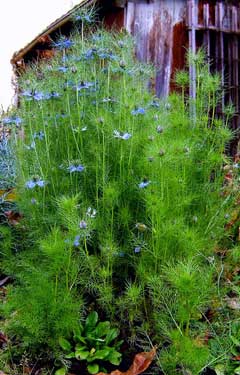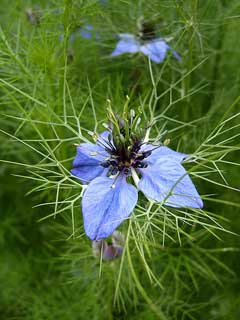 |
|
http://commons.wikimedia.org/wiki/User:Wildfeuer |
 |
| http://commons.wikimedia.org/wiki/User:Wildfeuer |
Translate this page:
Summary
Bloom Color: Blue, Pink. Main Bloom Time: Early summer, Late spring, Mid summer. Form: Upright or erect.
Physical Characteristics

 Nigella damascena is a ANNUAL growing to 0.6 m (2ft) by 0.2 m (0ft 8in) at a fast rate.
Nigella damascena is a ANNUAL growing to 0.6 m (2ft) by 0.2 m (0ft 8in) at a fast rate.
It is not frost tender. It is in flower from July to October, and the seeds ripen from August to October. The species is hermaphrodite (has both male and female organs) and is pollinated by Bees.
Suitable for: light (sandy), medium (loamy) and heavy (clay) soils and prefers well-drained soil. Suitable pH: mildly acid, neutral and basic (mildly alkaline) soils. It cannot grow in the shade. It prefers dry or moist soil.
UK Hardiness Map
US Hardiness Map
Synonyms
Plant Habitats
Cultivated Beds;
Edible Uses
Edible Parts: Oil Seed
Edible Uses: Condiment Oil
Seed - raw or cooked. Normally used as a condiment[2, 27, 46, 100], it has a nutmeg flavour[148].
References More on Edible Uses
Medicinal Uses
Plants For A Future can not take any responsibility for any adverse effects from the use of plants. Always seek advice from a professional before using a plant medicinally.
Expectorant
Expectorant[148].
References More on Medicinal Uses
The Bookshop: Edible Plant Books
Our Latest books on Perennial Plants For Food Forests and Permaculture Gardens in paperback or digital formats.

Edible Tropical Plants
Food Forest Plants for Hotter Conditions: 250+ Plants For Tropical Food Forests & Permaculture Gardens.
More

Edible Temperate Plants
Plants for Your Food Forest: 500 Plants for Temperate Food Forests & Permaculture Gardens.
More

More Books
PFAF have eight books available in paperback and digital formats. Browse the shop for more information.
Shop Now
Other Uses
Essential Oil
An essential oil distilled from the plant is used in perfumery and lipsticks[238]. The seed contains about 43.5% fatty oil, consisting of 97% total fatty acids of which 30% is free fatty acid[240]. No uses of this oil are given in the report.
Special Uses
Scented Plants
References More on Other Uses
Cultivation details
Landscape Uses:Container, Massing, Rock garden, Specimen, Woodland garden. An easily grown plant, succeeding in any good garden soil, preferring a sunny position[1, 108]. A very ornamental plant[1], there are some named varieties[188]. Plants are fast-growing[188] and often self-sow if the ground is disturbed by some means such as hoeing[K]. The flowers are very attractive to bees[108]. A greedy plant, inhibiting the growth of nearby plants, especially legumes[54]. Special Features:Attractive foliage, Naturalizing, Suitable for cut flowers, Suitable for dried flowers.
References Carbon Farming Information and Carbon Sequestration Information
Temperature Converter
Type a value in the Celsius field to convert the value to Fahrenheit:
Fahrenheit:
The PFAF Bookshop
Plants For A Future have a number of books available in paperback and digital form. Book titles include Edible Plants, Edible Perennials, Edible Trees,Edible Shrubs, Woodland Gardening, and Temperate Food Forest Plants. Our new book is Food Forest Plants For Hotter Conditions (Tropical and Sub-Tropical).
Shop Now
Plant Propagation
Seed - sow spring or early autumn in situ[1]. The autumn sowing might not be successful in harsh winters. Plants can be transplanted if necessary[200].
Other Names
If available other names are mentioned here
Native Range
TEMPERATE ASIA: Cyprus, Iran, Iraq, Syria, Turkey, Russian Federation-Ciscaucasia (Ciscaucasia (west)), Azerbaijan EUROPE: Ukraine (Krym), Albania, Bulgaria, Bosnia and Herzegovina, Greece (incl. Crete), Croatia, Italy (incl. Sardinia, Sicily), North Macedonia, Malta, Montenegro, Serbia, Slovenia, Spain (incl. Baleares), France (incl. Corsica), Portugal AFRICA: Spain (Canarias), Algeria, Libya, Morocco, Tunisia
Weed Potential
Right plant wrong place. We are currently updating this section.
Please note that a plant may be invasive in one area but may not in your area so it's worth checking.
Conservation Status
IUCN Red List of Threatened Plants Status :

Growth: S = slow M = medium F = fast. Soil: L = light (sandy) M = medium H = heavy (clay). pH: A = acid N = neutral B = basic (alkaline). Shade: F = full shade S = semi-shade N = no shade. Moisture: D = dry M = Moist We = wet Wa = water.
Now available:
Food Forest Plants for Mediterranean Conditions
350+ Perennial Plants For Mediterranean and Drier Food Forests and Permaculture Gardens.
[Paperback and eBook]
This is the third in Plants For A Future's series of plant guides for food forests tailored to
specific climate zones. Following volumes on temperate and tropical ecosystems, this book focuses
on species suited to Mediterranean conditions—regions with hot, dry summers and cool, wet winters,
often facing the added challenge of climate change.
Read More
Expert comment
Author
L.
Botanical References
50200
Links / References
For a list of references used on this page please go here
Readers comment
© 2010, Plants For A Future. Plants For A Future is a charitable company limited by guarantee, registered in England and Wales. Charity No. 1057719, Company No. 3204567.